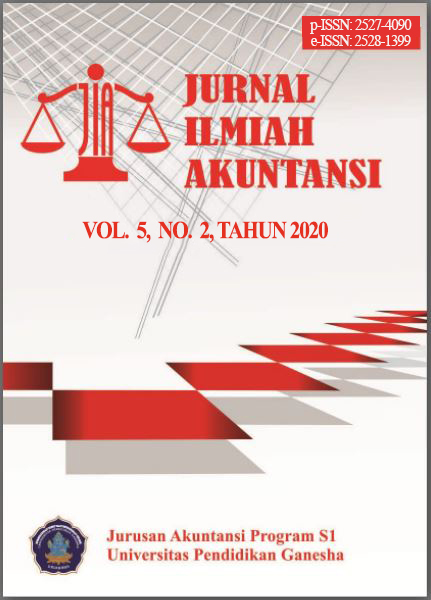Analyzing Performance of Islamic and Conventional Bank in Southeast Asia: The Firm Size View
DOI:
https://doi.org/10.23887/jia.v5i2.28981Keywords:
asset quality, conventional bank, efficiency, Islamic bank, stabilityAbstract
This paper examines how the firm size of Islamic and Conventional bank different in performance of efficiency, stability and asset quality. The result of the study is aimed to see the extent of Islamic banks compete with conventional banks in the ASEAN context. The type of this research is a comparative study. The data is obtained from 31 conventional banks and 17 Islamic banks in Southeast Asia over the period of 2013-2017. Collected data are analyzed using DEA Analysis, Loan Loss Provision, Loan Loss Reserves and Z_Score. The findings showed that there were differences in efficiency and stability between conventional banks and Islamic banks based on firm size.References
Abdul-Majid, M., Saal, D. S., & Battisti, G. (2010). Efficiency in Islamic and Conventional Banking: An International Comparison. Journal of Productivity Analysis, 34(1), 25–43. https://doi.org/10.1007/s11123-009-0165-3
Abrar, T., Ahmed, F., & Kashif, M. (2018). Financial Stability of Islamic versus Conventional Banks in Pakistan. Al-Iqtishad: Jurnal Ilmu Ekonomi Syariah, 10(2), 341–366. https://doi.org/10.15408/aiq.v10i2.6500
Alghfais, M. (2017). A Comparative Study between Islamic and Conventional Banks-The case of Saudi Arabia: A Binary Logistic Regression Approach (No. WP/17/4).
Aziz, S., Husin, M. M., & Hashmi, S. H. (2016). Performance of Islamic and Conventional Banks in Pakistan: A Comparative Study. International Journal of Economics and Financial Issues, 6(4), 1383–1391.
Beck, T., Demirgüç-Kunt, A., & Merrouche, O. (2013). Islamic vs. Conventional Banking: Business Model, Efficiency and Stability. Journal of Banking and Finance, 37(2), 433–447. https://doi.org/10.1016/j.jbankfin.2012.09.016
Čihák, M., & Hesse, H. (2010). Islamic Banks and Financial Stability: An Empirical Analysis. Journal of Financial Services Research, 38(2), 95–113. https://doi.org/10.1007/s10693-010-0089-0
Farooq, M., van Wijnbergen, S., & Zaheer, S. (2015). Will Islamic Banking Make the World Less Risky? An Empirical Analysis of Capital Structure, Risk Shifting and Financial Stability. In Tinbergen Institute Discussion Papers 15-051/VI/DSF92. https://doi.org/10.2139/ssrn.2605358
Ghozali, I. (2016). Aplikasi Analisis Multivariete Dengan Program IBM SPSS 23 (Edisi 8). In Universitas Diponegoro. Semarang: Badan Penerbit Universitas Diponegoro.
Holmstrom, B. R., & Tirole, J. (1989). Chapter 2 The theory of the firm. Handbook of Industrial Organization. https://doi.org/10.1016/S1573-448X(89)01005-8
Karim, M. Z. A., Chan, S. G., & Hassan, S. (2010). Bank Efficiency and Non-Performing Loans: Evidence from Malaysia and Singapore. Prague Economic Papers, 19(2), 118–132. https://doi.org/10.18267/j.pep.367
Kassim, S. H., & Shabri, M. (2010). Impact of Financial Shocks on Islamic Banks: Malaysian Evidence during 1997 and 2007 Financial Crises. International Journal of Islamic and Middle Eastern Finance and Management, 3(4), 291–305. https://doi.org/10.1108/17538391011093243
Komijani, A., & Taghizadeh-Hesary, F. (2019). An overview of Islamic banking and finance in Asia. In Routledge Handbook of Banking and Finance in Asia. https://doi.org/10.4324/9781315543222-28
Kumar, K. B., Rajan, R. G., & Zingales, L. (2001). What Determines Firm Size? (No. NBER Working Paper No. w7208). Chicago.
Miah, M. D., & Uddin, H. (2017). Efficiency and Stability: A Comparative Study between Islamic and Conventional Banks in GCC Countries. Future Business Journal, 3(2), 172–185. https://doi.org/10.1016/j.fbj.2017.11.001
Rashid, A., & Jabeen, S. (2016). Analyzing Performance Determinants: Conventional versus Islamic Banks in Pakistan. Borsa Istanbul Review, 16(2), 92–107. https://doi.org/10.1016/j.bir.2016.03.002
Rosman, R., Wahab, N. A., & Zainol, Z. (2014). Efficiency of Islamic Banks during the Financial Crisis: An analysis of Middle Eastern and Asian Countries. Pacific-Basin Finance JournalBasin Finance Journal, 28, 76–90. https://doi.org/10.1016/j.pacfin.2013.11.001
Said, A. (2013). Risks and Efficiency in The Islamic Banking Systems: The Case of Selected Islamic Banks in MENA Region. International Journal of Economics and Financial Issues, 3(1), 66–73.
Sakti, M. R. P., & Mohamad, A. (2018). Efficiency, Stability and Asset Quality of Islamic vis-à-vis Conventional Banks: Evidence from Indonesia. Journal of Islamic Accounting and Business Research, 9(1), 378–400. https://doi.org/10.1108/JIABR-07-2015-0031
Shaikh, A., Sharif, S., & Arif, I. (2016). Comparison of Islamic Banks with Conventional Banks: Evidence from an Emerging Market. Journal of Management Sciences, 3(1), 24–33. https://doi.org/10.20547/jms.2014.1603102
Wahid, M. A., & Dar, H. (2016). Stability of Islamic versus Conventional Banks: A Malaysian Case. Jurnal Ekonomi Malaysia, 50(1), 111–132. https://doi.org/10.17576/JEM-2016-5001-09
Downloads
Published
Issue
Section
License
JIA (Jurnal Ilmiah Akuntansi) is licensed under a Creative Commons Attribution-ShareAlike 4.0 International License
Authors who publish with this journal agree to the following terms:
- Authors retain copyright and grant the journal right of first publication with the work simultaneously licensed under a Creative Commons Attribution Attribution-NonCommercial-NoDerivatives 4.0 International License that allows others to share the work with an acknowledgment of the work's authorship and initial publication in this journal.
- Authors are able to enter into separate, additional contractual arrangements for the non-exclusive distribution of the journal's published version of the work (e.g., post it to an institutional repository or publish it in a book), with an acknowledgment of its initial publication in this journal.
- Authors are permitted and encouraged to post their work online (e.g., in institutional repositories or on their website) before and during the submission process, as it can lead to productive exchanges and earlier and greater citation of published work (See The Effect of Open Access).




1.png)



